|
|
 |

My last column of 2017 took a retrospective look at some of the vinous highlights I observed during the year, whereas this column is based on the premise that, “Past is Prologue,” which really rings true in the world of wine. For example, some of the most exciting wines I tasted last year were astonishing Syrah-based reds from France’s Northern Rhône Valley, but they are only now becoming available for sale. So, based on observations from last year, here are some suggestions for jump-starting your wine year of 2018, with more to come in the WRO Blog space.
Northern Rhône Reds from 2015 and 2016:
Many wine lovers have heard that Bordeaux enjoyed an excellent vintage in 2015, but relatively few are aware that the Northern Rhône was at least as successful, and the 2016s from the Northern Rhône are probably better than the 2015s from either region. Why, you might ask, am I bringing Bordeaux into this at all, rather than just addressing the Rhône? At the risk of being rude, the answer is that buying Bordeaux from 2015 at this point 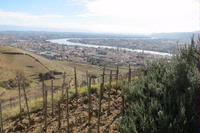 makes you a chump, whereas buying 2015s or 2016s from the Northern Rhône is an act of prescient genius. makes you a chump, whereas buying 2015s or 2016s from the Northern Rhône is an act of prescient genius.
Most high-quality Bordeaux sold in the USA must be purchased on a “futures” basis, and the 2015s were expensive when first offered, and are now even more painfully pricey. Bordeaux wines remain much more famous than Rhônes worldwide, but that only means you are pitted against buyers in China, Singapore, Russia and elsewhere when purchasing them. One need not be a stock market wizard to understand that “buying high” and chasing what everyone else is chasing is an act of commercial idiocy.
Of course, failing to chase what everyone else is chasing could be ill-advised if there’s nothing else first-rate to chase. But there is. The Syrah-based wines made in 2015 in Hermitage, Côte-Rôtie, Cornas, Saint-Joseph and Crozes-Hermitage are marvelous, with wonderful fruit flavors to counterbalance their tannins and wood. Equally important, the character of the fruit is strikingly pure, yet the wines aren’t at all “grapey” or obvious--they still have hints of the subtly earthy rusticity that makes Northern Rhône reds so exciting.
The appellations above are listed in roughly descending order of average wine cost, so dive in according to your budgetary constraints. But whatever you do, save some money for the 2016s, which will become available for sale later this year. Many vintners with whom I spoke during 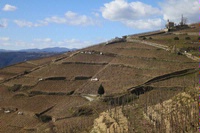 a week of tasting in April of 2017 thought that 2016 was the better of the two vintages, and that opinion was especially credible since most were not yet selling their 2015 at that time. For example, Pierre Jean Villa told me that the weather conditions before and during the harvest in 2016 permitted winegrowers to make exactly the style of wine they desired. He reported that the days were very even in temperature, ripening the grapes slowly and steadily, and that nights were cool, keeping the fruit fresh as it ripened. Moreover, with no threat of rain, nor heat spikes causing rushed picking or traffic jams in cellars, the potential for greatness was present for all who sought it conscientiously. a week of tasting in April of 2017 thought that 2016 was the better of the two vintages, and that opinion was especially credible since most were not yet selling their 2015 at that time. For example, Pierre Jean Villa told me that the weather conditions before and during the harvest in 2016 permitted winegrowers to make exactly the style of wine they desired. He reported that the days were very even in temperature, ripening the grapes slowly and steadily, and that nights were cool, keeping the fruit fresh as it ripened. Moreover, with no threat of rain, nor heat spikes causing rushed picking or traffic jams in cellars, the potential for greatness was present for all who sought it conscientiously.
If you prefer reds from the southern Rhône to those from the north, our preferences aren’t shared, but the reds and whites from the south are also very good in 2015 and potentially outstanding in 2016. My strategy? Keep one eye on northern Rhône reds from 2015 and 2016, one eye on my piggy bank, and both hands on my sledgehammer….
Comeback Grape Variety of the Year…Barbera
I love Barbera from Piedmont in the northwest of Italy, and so too do the people and vintners I know who live in the broad area around Alba and Asti where most of it is grown and made. Which raises the question: Why should Barbera be in need of a comeback at all?
The short answer is: Climate change. The past two decades have seen sharp rises in temperatures in the area, which also grows Nebbiolo, from which some of the world’s finest wines are made in Barolo, Barbaresco and beyond. The connection here is that Nebbiolo ripens notably later than Barbera, so historically, it had to be planted on the prime, south-facing growing sites in this hilly region if it was to ripen fully and achieve its unrivaled potential. Barbera--as well as Dolcetto--were accorded sites with less sun exposure to the sides of the south faces, where they did just fine. However, once the growing seasons started heating up year after year, growers would replace Barbera vines with Nebbiolo, which could now ripen in those spots, and make wine commanding higher prices.
To be candid, good Nebbiolo is “classier” than good Barbera, as almost everyone in the area will agree readily. Moreover, vintners are running businesses rather than some sort of conservation operation, and their accountants could have them committed to asylums if they stuck with Barbera in spots that can now make Langhe Nebbiolo or Nebbiolo d’Alba--much less Barbaresco or Barolo.
Still, “classiness” isn’t the end of the issue. A tuxedo is classier than a pair of jeans, but in my view, any guy who wants to wear a tuxedo every day is a jackass. Similarly, every great Barolo producer I know loves to enjoy Barbera several times each week, with charcuterie or pizza or the more rustic “comfort foods” that are--in their way--every bit as pleasing as intricate dishes offered in high-end restaurants.
Which brings us (at long last) to Barbera's comeback. This is happening partly because a notable number of vintners in Barbaresco and Barolo are simply stiff-arming their accountants to preserve their ability to make Barbera. Alternatively, they are buying vineyards or fruit from elsewhere in Piedmont for the same reason.
However, the really heroic backers behind the comeback are located elsewhere in Piedmont, especially in and around the province of Asti, and 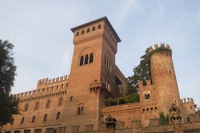 specifically near the towns of Nizza Monferrato, Vinchio, Castelnuovo, Calcea, Agliano, Belveglio and Rocchetta. This list could be expanded, as the Barbera renaissance is still very much underway and also spreading to smaller hamlets such as Gabiano, where absolutely delicious Barbera d’Asti DOCG “La Braja” is being made by Castello di Gabiano--essentially the only producer in town. specifically near the towns of Nizza Monferrato, Vinchio, Castelnuovo, Calcea, Agliano, Belveglio and Rocchetta. This list could be expanded, as the Barbera renaissance is still very much underway and also spreading to smaller hamlets such as Gabiano, where absolutely delicious Barbera d’Asti DOCG “La Braja” is being made by Castello di Gabiano--essentially the only producer in town.
My friend and WRO colleague Michael Apstein is ahead of me in learning about Barbera wines from this area, but I’m hoping to reduce his lead a little in the year ahead, both by traveling there and tasting here in the USA. Maybe we’ll meet in the Barbera section of your wine shop, so keep an eye out…I’ll be the bald guy in the jeans.
Off-Beaten-Path Wine Destination of the Year…Bierzo
If you are a wine lover who still hasn’t made travel plans for 2018, you could go to Paris or Venice and get trampled by the crowds, or you could take my advice and go to someplace you’ve probably never even heard of--Bierzo--and drink some of the region’s Mencía…which is also rather obscure, but arguably on its way to becoming Spain’s best red wine. The leading renditions already rival or surpass top offerings from Rioja, Priorat and Ribera del Duero at the very top of Spain’s quality pyramid.
Praise such as this could lead you to ask, “If these wines are so outstanding, why aren’t they more widely known and appreciated? There 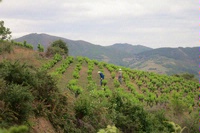 are several inter-related answers to this. First, Bierzo is an inland zone that is relatively removed from major transportation arteries or ports, which offered important export advantages to regions such as Bordeaux for centuries. Second, Bierzo is surrounded by mountains and quite rugged in topography, which helps explain why wine was long made mostly for local consumption. Third, Bierzo’s rather isolated setting hampered economic development aside from agriculture, leading many inhabitants to emigrate and resulting in the outright abandonment of some of the steepest and best growing sites. are several inter-related answers to this. First, Bierzo is an inland zone that is relatively removed from major transportation arteries or ports, which offered important export advantages to regions such as Bordeaux for centuries. Second, Bierzo is surrounded by mountains and quite rugged in topography, which helps explain why wine was long made mostly for local consumption. Third, Bierzo’s rather isolated setting hampered economic development aside from agriculture, leading many inhabitants to emigrate and resulting in the outright abandonment of some of the steepest and best growing sites.
Although the revival of high-end wine geared toward export from Bierzo is fairly new (roughly two decades), winemaking per se is certainly not. The Romans arrived in force, conquering and expanding the pre-existing 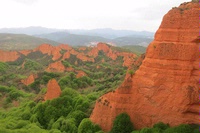 settlement of Bergidum and engaging in intensive, hydraulic gold mining (leaving behind Las Médulas, a UNESCO World Heritage site that is uncanny in being both devastated and gorgeous). As they did almost everywhere, the Romans established viticulture in earnest, which was then revived by monastic orders, especially the Cistercians in the 9th century. settlement of Bergidum and engaging in intensive, hydraulic gold mining (leaving behind Las Médulas, a UNESCO World Heritage site that is uncanny in being both devastated and gorgeous). As they did almost everywhere, the Romans established viticulture in earnest, which was then revived by monastic orders, especially the Cistercians in the 9th century.
Religion and wine have been intertwined ever since, and not merely for sacramental purposes. The Camino de Santiago (or Way of St. James) became Christendom’s principal pilgrimage route during the Middle Ages, with the main trail running straight through Bierzo. A recent upsurge now brings more than 200,000 hikers through the notably under-populated region, and no doubt Mencía would be even more obscure if not for all of those pilgrims walking through the area.
To be clear, you do not need to walk to Bierzo. The drive from Madrid takes less than three hours, or you could drive for just an hour after taking a connecting flight to León (which, by the way, is beautiful and fun and is home to one of the most under-rated cathedrals in all of Europe). Situated in the Sil Valley, Bierzo located in the extreme northwest corner of Castilla y León, bordering Galicia to the west and Asturias to the north. Ringed by mountains, it strikes the visitor’s eye as a well-defined bowl, though locals are quick to correct this, likening it instead to a pot. Why this should be a matter of dispute is unclear, but everybody agrees that quality stems directly from the very old, low-yielding vines perched at elevations of 1,500 – 3,000 feet.
The region’s growing conditions could hardly be better suited to Mencía. Vulnerable to wind damage, this prized local variety is sheltered by Bierzo’s mountains, which also reduce rainfall from the Atlantic that would otherwise prey upon Mencía’s susceptibility to botrytis. Bierzo has both maritime and continental conditions. Interestingly, those two influences wax and wane from vintage to vintage, and even from one sector of the region to another within a single growing season. Some years produce a preponderance of rich, ripe wines, whereas cooler years with more Atlantic influence have led inexperienced tasters to pigeonhole Bierzo Mencía as a bright, lighter-bodied wine. The more comprehensive fact of the matter is that these wines can be either big or bright, depending on vintage and vineyard, or big and bright at once--which is when they are most astonishing.
If I were you, I’d probably seek lodging in Villafranca del Bierzo, which is a charming medieval town with plenty of modestly priced lodgings for 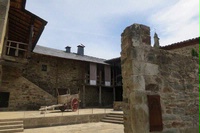 pilgrims but also a beautiful Parador, a high-end hotel with fine food and amazingly reasonable prices, presumably due to relative remoteness (another advantage of not being trampled in Venice). If you roll the dice and take my advice, I’ll be glad to recommend bodegas to visit or even work to make appointments on your behalf. No kidding…that’s how much I love this place. Just write to me at: michael@franzwine.com pilgrims but also a beautiful Parador, a high-end hotel with fine food and amazingly reasonable prices, presumably due to relative remoteness (another advantage of not being trampled in Venice). If you roll the dice and take my advice, I’ll be glad to recommend bodegas to visit or even work to make appointments on your behalf. No kidding…that’s how much I love this place. Just write to me at: michael@franzwine.com
|
 |
|